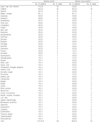Abstract
Background
To evaluate the safety and effectiveness of rosiglitazone/metformin in patients with type 2 (non-insulin-dependent) diabetes.
Methods
A total of 982 patients were enrolled by 19 physicians from November 2003 to November 2010. Patients treated with rosiglitazone/metformin at least once, were included in safety assessment. The incidences of adverse events (AEs) and serious adverse events (SAEs) were estimated. The effectiveness of rosiglitazone/metformin was evaluated through change in fasting blood glucose (FBG), 2-hour postprandial glucose (2hr PPG), Hemoglobin A1c (HbA1c).
Results
Of the 982 patients, 713 patients with the mean age of 56.4 ± 11.5 years were included in the safety assessment. A total of 130 AEs were reported from 110 patients (15.4 %). The most frequent AEs were upper respiratory infection (2.4 %), oedema (2.2 %), gastritis (1.3 %), and weight increase (1.1 %). The incidence of unexpected AEs was 5.9 % (42/713, 47 AEs). Three SAEs such as bacterial pneumonia, hyperglycaemia, chest pain were reported in 2 patients. As it is about effectiveness, patients showed statistically significant reductions after treatment of rosiglitazone/metformin in FBG, 2hr PPG, and HbA1c (P<0.001 by paired t-test, for all).
Figures and Tables
References
2. Holman RR, Paul SK, Bethel MA, Matthews DR, Neil HA. 10-year follow-up of intensive glucose control in type 2 diabetes. N Engl J Med. 2008. 359(15):1577–1589.

3. Ko KD, Kim BH, Oh SI, Um CS, Shin DW, Lee HW. What are patient factors associated with the quality of diabetes care?: results from the Korean National Health and Nutrition Examination Survey. BMC Public Health. 2012. 12:689.

4. Miller RA, Birnbaum MJ. An energetic tale of AMPK-independent effects of metformin. J Clin Invest. 2010. 120(7):2267–2270.

5. Bourg CA, Phillips BB. Rosiglitazone, myocardial ischemic risk, and recent regulatory actions. Ann Pharmacother. 2012. 46(2):282–289.

6. Ko SH, Kwon HS, Song KH, Ahn YB, Yoon KH, Yim HW, Lee WC, Park YM. Long-term changes of the prevalence and control rate of hypertension among Korean adults with diagnosed diabetes: 1998-2008 Korean National Health and Nutrition Examination Survey. Diabetes Res Clin Pract. 2012. 97(1):151–157.

7. Handelsman Y, Mechanick JI, Blonde L, Grunberger G, Bloomgarden ZT, Bray GA, Dagogo-Jack S, Davidson JA, Einhorn D, Ganda O, Garber AJ, Hirsch IB, Horton ES, Ismail-Beigi F, Jollinger PS, Jones KL, Jovanovic L, Lebovitz H, Levy P, Moghissi ES, Orzeck EA, Vinik AI, Wyne KL. American Association of Clinical Endocrinologists Medical Guidelines for Clinical Practice for developing a diabetes mellitus comprehensive care plan. Endocr Pract. 2011. 17:Suppl 2. 1–53.

8. Hong JS, Kang HC. Relationship between oral antihyperglycemic medication adherence and hospitalization, mortality, and healthcare costs in adult ambulatory care patients with type 2 diabetes in South Korea. Med Care. 2011. 49(4):378–384.

9. Bell DS. Combine and conquer: advantages and disadvantages of fixed-dose combination therapy. Diabetes Obes Metab. 2012.
10. Choi NK, Park BJ. Adverse drug reaction surveillance system in Korea. J Prev Med Public Health. 2007. 40(4):278–284. (Korean).

11. Kahn SE, Haffner SM, Heise MA, Herman WH, Holman RR, Jones NP, Kravilz BG, Lachin JM, O'Neill MC, Zinman B, Viberti G. Glycemic durability of rosiglitazone, metformin, or glyburide monotherapy. N Engl J Med. 2006. 355(23):2427–2443.

12. Kim HA. Attitude and knowledge of community pharmacists to adverse drug reaction reporting. Korean J Clin Pharm. 2009. 19(2):159–166. (Korean).
13. Lee HR, Kim YS, Sung S, et al. Post-marketing surveillance for the safety and efficacy of irbesartan in patients with hypertension. J Pharmacoepidemiol Risk Manag. 2009. 2(1):30–37. (Korean).




 PDF
PDF ePub
ePub Citation
Citation Print
Print









 XML Download
XML Download